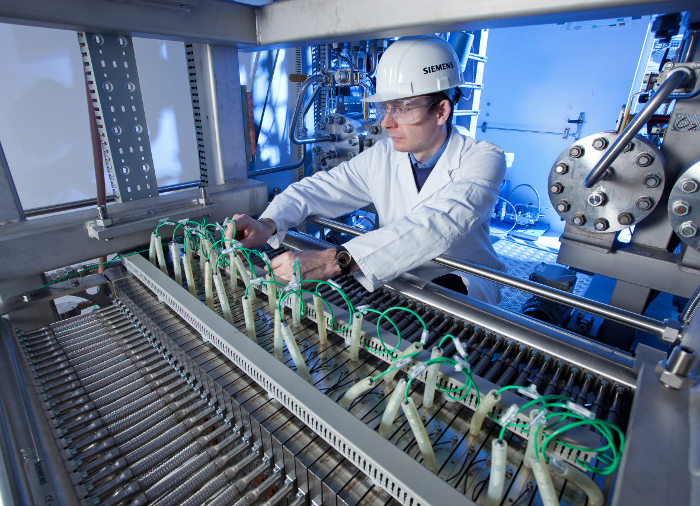With hydrogen or synthetic fuels hailed as the way to provide much-needed dispatchability for intermittent renewables generation, the coastal regions of Germany and the Netherlands could host 110 GW of electrolyzer capacity by mid century.
That is the prediction of a report published by Dutch-headquartered transmission system operator TenneT and compatriot gas infrastructure company Gasunie.
The businesses in February considered what energy infrastructure should look like by 2050 and have returned to their findings to model three routes to net-zero-carbon economies in the Netherlands and Germany by 2050, in line with the European Commission vision. The scenarios differ according to the degree of electrification, volume of green gas imports and renewable energy deployment.
Inter-linked
The study suggests the gas and electricity systems will be much more closely linked in 2050, to enable growth in electrolyzer and methane production capacity.
“We need to integrate the gas and electricity grids to achieve the energy policy objectives,” said TenneT chief executive Manon van Beek. “To do this, we need an integrated European energy system. National energy transitions are important, and will bring the first significant steps towards the expansion of renewables, but if we want the energy transition to be timely and affordable we will need close political cooperation within Europe.”
The volume of green gas on the market will be driven by demand for cars and heating while the degree of electrification achieved in the economy, and the generation capacity of renewables in operation, will influence how infrastructure should be planned.
Datasets
TenneT and Gasunie gathered data from the ten-year network development plans of Germany and the Netherlands, from CO2 reduction strategies and from coal and nuclear decommissioning schedules and overlapped them with information about projected interconnector and transmission capacity for electricity, gas, hydrogen and methane. The latter datasets were provided by the European Network of Transmission System Operators for Electricity (ENTSO-E) and gas equivalent ENTSO-G.
All three scenarios assumed 95% decarbonization by mid century. The resulting ‘Integrated System Expansion Model’ is said to simulate the impact of varying levels of hydrogen and methane usage on energy system costs, infrastructure utilization rates and power plant dispatch decisions.
Popular content
“The existing gas and electricity networks jointly play a crucial role in the energy system of the future,” said Gasunie chief executive Han Fennema. “In order to cope with increasing fluctuations in the energy network, we need our gas and electricity infrastructures to be seamlessly aligned. Linking TenneT’s network to Gasunie’s will provide the flexibility required by the energy system; it will also keep the system reliable and affordable.”
Joint effort
The study is the first to consider jointly maximizing investment and dispatch scenarios across both networks, to better establish the value offered by power-to-gas. For example, the authors modeled dispatch and grid flexibility options with reference to linked gas and electricity networks which enabled consideration of the number of hours per year when electrolyzers would be operating with full loads across the three scenarios.
The model based on the highest volume of renewable energy generation capacity would see around 110 GW of electrolyzer capacity rolled out between 2040 and 2050 in Germany and the Netherlands. Modest electrification with a still considerable volume of clean energy assets would drive 63 GW of electrolyzers and a smaller degree of electrification and renewables capacity would result in 8 GW of electrolyzer capacity in 2050, according to the study.
The small figure for the latter scenario reflects an energy mix where renewables supply electricity demand but without surplus generation to feed electrolysis. In such a case, green gas imports would supply demand, with electrolyzers operating at full load for only around 1,900 hours in 2050.
Different outcomes
In the scenario that assumes greater gas use, electric demand would be lower, allowing for more renewable energy to be used for power-to-gas. Hence, an economy running on significant amounts of green gas and high renewables capacity would see electrolyzers performing 4,770 full-load hours in mid century. If mobility, heating and industrial processes are tweaked to operate on electricity rather than gaseous fuels, and large over-capacities of renewables have been deployed, electrolyzers would be expected to clock 6,990 full-load hours. In the latter scenario, hydrogen would serve as seasonal storage and be turned back into electricity and heat, rather than being used as fuel for mobility, for example.
Methanation units, meanwhile, are unlikely to be developed in either scenario, primarily due to the bigger efficiency losses associated with them. Electricity demand and hydrogen generation are likely to be addressed before methanation.
The current gas network can accommodate only a fraction of hydrogen content without costly updates. Synthesizing methane from hydrogen renders it carbon-neutral, albeit with an added, energy-intensive conversion step which cranks up the cost even further.
This content is protected by copyright and may not be reused. If you want to cooperate with us and would like to reuse some of our content, please contact: editors@pv-magazine.com.



By submitting this form you agree to pv magazine using your data for the purposes of publishing your comment.
Your personal data will only be disclosed or otherwise transmitted to third parties for the purposes of spam filtering or if this is necessary for technical maintenance of the website. Any other transfer to third parties will not take place unless this is justified on the basis of applicable data protection regulations or if pv magazine is legally obliged to do so.
You may revoke this consent at any time with effect for the future, in which case your personal data will be deleted immediately. Otherwise, your data will be deleted if pv magazine has processed your request or the purpose of data storage is fulfilled.
Further information on data privacy can be found in our Data Protection Policy.